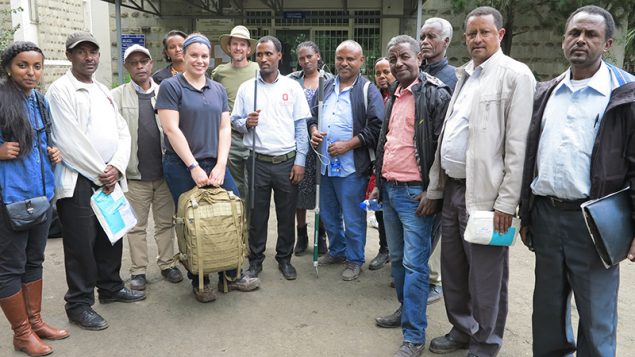Prioritizing Zoonotic Diseases in Ethiopia

Collaboration is the key to success when tackling any complex issue. CDC’s Division of High-Consequence Pathogens and Pathology (DHCPP) discovered just how critical collaboration can be when they launched a project in Ethiopia to tackle some of the country’s dangerous yet neglected zoonotic pathogens. Zoonotic diseases are those spread to humans by animals, and 3 out of every 4 new or emerging infectious diseases are zoonotic.
Ethiopia is home to a host of zoonotic pathogens, including many that are considered to be a threat to the United States and other countries around the world. Ethiopia in particular is vulnerable to the effects of zoonotic diseases as the economy is largely dependent on agriculture, and it is home to the largest animal population in Africa.
In 2015, CDC conducted a zoonotic disease prioritization workshop in Ethiopia that guided a range of government agencies through the process of determining zoonotic diseases of greatest public health threat to the country. In the prioritization process, 43 potential zoonotic diseases of concern were vetted through a set of criteria determined jointly by the Ethiopian agencies and partners. As a result of the prioritization process, human and animal health agencies jointly selected five zoonotic diseases they can collaboratively begin to tackle. These were rabies, anthrax, brucellosis, leptospirosis, and echinococcosis.
In the two years since the prioritization process, DHCPP has been assisting animal and human health agencies in Ethiopia in developing laboratory capacity for rabies and brucellosis and workforce training to improve disease detection and develop prevention and control strategies. Ethiopia is using the One Health approach to develop national control and prevention strategies for rabies and anthrax, with a goal of validating the approaches in December 2017. Based on the current draft of the anthrax strategy, DHCPP is committed to assisting Ethiopia to improve surveillance, laboratory diagnostic capacity and vaccine distribution for anthrax.

With the support from DHCPP and other partners, workforce development and training have been a vital effort to ensure a sustained capacity to undertake zoonotic disease prevention and response in Ethiopia. As part of the ongoing collaborative effort to help bolster the country’s rabies initiatives, DHCPP staff have been consulting with the National Veterinary Institute leadership to improve the potency of the animal rabies vaccine being produced in the country. Additionally, in 2017, nearly 200 supervisory health officers and roughly 1,000 health extension workers participated in a rabies control and prevention training sponsored by the Ethiopian Public Health Institute.
In order to better understand the burden of brucellosis and circulating strains of the disease in Ethiopia, CDC has trained over 50 laboratorians on diagnostic methods for brucellosis and an additional 45 people have been trained on sample and data collection. Nearly 3,000 human samples and 6,000 animal samples have been collected from households in three regions in Ethiopia. The data collection has provided the framework for a historic risk mapping surveillance tracking initiative aimed at assessing the health and economic impact of brucellosis in human and animal populations. The regional and national level laboratories are now working on testing the human and animal samples to determine the burden and circulating strains of brucellosis. This data will be used by the Ethiopian Ministry of Livestock and Fisheries to determine the most appropriate prevention and control activities. These activities are improving Ethiopia’s ability to prevent, detect, and respond to zoonotic diseases outbreaks, ensuring that future outbreaks are contained quickly and safely before they cross borders making Ethiopians and populations around the world safer from zoonotic disease threats.
To view a printable version of this page: Prioritizing Zoonotic Diseases in Ethiopia [PDF – 1 page]
